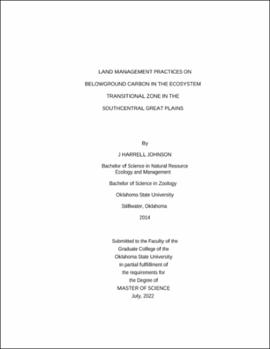| dc.contributor.advisor | Zou, Chris | |
| dc.contributor.author | Johnson, J Harrell | |
| dc.date.accessioned | 2023-04-12T19:38:32Z | |
| dc.date.available | 2023-04-12T19:38:32Z | |
| dc.date.issued | 2022-07 | |
| dc.identifier.uri | https://hdl.handle.net/11244/337365 | |
| dc.description.abstract | The mesic grasslands in the Great Plains of the USA have a great capacity to sequester atmospheric CO2 into soil. Over 5.2 million hectares of such grasslands in the southern Great Plains are “go-back” lands; areas that were once tilled and cultivated, severely degraded and deprived of soil carbon. These grasslands are under rapid woody encroachment and potential lands for planting switchgrass (Panicum virgatum) for biofuel production. However, there is no systematic study of the historical and recent land-use impact on soil carbon storage and dynamics. In this study, I selected six adjacent sites representing three land uses [non-grazed prairie, grazed prairie, and eastern redcedar (Juniperus virginiana L.) woodland)] and three recent land-use changes (eastern redcedar to prairie, eastern redcedar to switchgrass, and prairie to switchgrass) in the southcentral Great Plains. I collected a total of 120 intact soil cores from the 0–30 cm depth to determine the bulk density (ρb), percent soil organic carbon (C–content), and percent nitrogen (N–content) and calculated soil organic carbon stock (C–stock) associated with different land uses and land-use history. ρb was greater in sites with recent mechanical disturbance, whereas C–content and N–content showed the opposite trend except for N–content under redcedar. C–stock (mean ± SE) was 4,671 ±523 g C m-2 for the 0–30 cm soil across all sites, which was substantially lower than that reported for remnant native prairie in this region. C–stocks under prairie sites were 10 – 15% greater than the encroached redcedar woodland. Conversion of an existing prairie or redcedar woodland to a switchgrass biofuel system was associated with substantially lower of soil carbon in the upper 30 cm. Our results suggest that these “go-back” lands can be a significant carbon sink and continue sequestering carbon. The reported trend from other studies of C and N generally increasing in the mineral soil following redcedar afforestation of grasslands is not universal, particularly on sites recovering from past cultivation. | |
| dc.format | application/pdf | |
| dc.language | en_US | |
| dc.rights | Copyright is held by the author who has granted the Oklahoma State University Library the non-exclusive right to share this material in its institutional repository. Contact Digital Library Services at lib-dls@okstate.edu or 405-744-9161 for the permission policy on the use, reproduction or distribution of this material. | |
| dc.title | Land management practices on belowground carbon in the ecosystem transitional zone in the south-central Great Plains | |
| dc.contributor.committeeMember | Will, Rodney | |
| dc.contributor.committeeMember | Fuhlendorf, Samuel | |
| osu.filename | Johnson_okstate_0664M_17768.pdf | |
| osu.accesstype | Open Access | |
| dc.type.genre | Thesis | |
| dc.type.material | Text | |
| dc.subject.keywords | carbon storage | |
| dc.subject.keywords | encroachment | |
| dc.subject.keywords | Juniperus virginiana l. | |
| dc.subject.keywords | eastern redcedar | |
| dc.subject.keywords | panicum virgatum | |
| dc.subject.keywords | switchgrass | |
| dc.subject.keywords | restored prairie | |
| dc.subject.keywords | woody plant removal | |
| thesis.degree.discipline | Natural Resources and Ecology Management | |
| thesis.degree.grantor | Oklahoma State University | |
